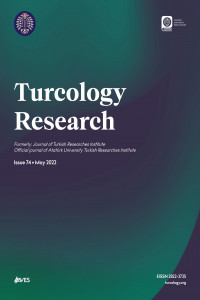MEHMED RÂŞİD EFENDİ’NİN, “NAZÎDE” KASİDESİNİN, ESKİ TÜRK, ARAP VE ACEM KÜLTÜR TARİHİNDEN TAŞIDIĞI İZLER
Yazımıza Râşid Efendi’yi kısaca tanıttıktan sonra, şâirin bu kasideyle ne yapmak istediğini söylediği girizgâh (konuya geçiş beyti) beyti ile başlayıp, medhiyye bölümünden; peygamberlerden ve peygamberimizden, dört halifeden, sahabelerden ve peygamberimizin kızı, Hz. Ali’nin hanımı Hz. Fâtıma’dan bahseden 5. 6. 7. 8. 9. 10. beyitler ele alındı. Yine kasidenin medhiyye bölümünden; Osmanlı’dan, Osmanlı Padişahı’nın tutumundan, Ziyâ Paşa’nın Kıbrıs Mutasarrıflığına tayininden bahseden 11. 14. 15. beyitler incelendi. Aynı bölümden Arap kültür tarihinden bahseden 17. 18. 19. beyitler üzerinde duruldu. Bu bölümün 23. beytinde Türk kültürünün İslâmiyet öncesi durumuyla ilgili gelenek ve kültür kavramları diğer kaynaklardan alınan bilgilerin paralelinde yorumlandı. 27. beyitte, Osmanlı Padişahı Abdulaziz’in Mekke ve Medine halkına cömertçe yardımları dile getirildi. 29. beyitte, Osmanlı Hânedanı ile beraber tarih sahnesine çıkan ve uzun zaman vezir-i âzamlık makamını ellerinde tutmuş olan bir Türk ailesi hakkında verilen bilgiler üzerinde duruldu. Yukarıda belirtilen Türk, Arap, Acem tarih ve kültürleriyle ilgili 31. 32. 33. 37. 38. 39. 40. 41. 42. 43. 44. 45. 46. 47. 48. 49. 51. 52. 59. 61. 67. 68. 70. 71. 73. 76. 77. 78. 79. 81. 89. 91. beyitler üzerinde çalışılıp çıkarılan gerekli bilgiler okuyucuların dikkatine sunuldu.
The Prints Which Brought From The Old Turkish, Arabic Culture History Of Mehmed Raşid Gentelman’s “Nazide” Qasida
After having introduced Raşid Gentelman in short,beginning our writing with the couplet of the introduction to the subject on which he said what he wanted to do with this qasida,from the chapter of praising; the couplets of 5th,6th,7th,8th,9th,10th which mention about prophets and our prophet,four caliphs,the companians of the prophet and our prophet’s daughter ,Hz.Ali’s wife Hz.Fatma have been taken in hand. Again from the praising chapter of the qasida; the couplets of 11th,14th,15th which mention about Ottoman,the behaviours of the Sultan f the Ottoman Empire,the appointment of Ziya Pasha’s to the Cyprus adminstration have been studied. From the same chapter on the couplets of 17th,18th,19th which mention about Arabic culture history have been considered. On the23rd couplet of this chapter the concepts of tradition and culture related to the position of Turkish culture prior to Islam have been commented in the light of the information taken from the other sources. On the 27th couplet,the helps of the Sultan of Ottoman Empire generously to the people of Mekke and Medine have been caused to talk. On the 29th couplet ,the information given about a Turkish family which appear in the scene of history with the Ottoman family and hold the post of Head Ministry for a long time have been considered. Identified above the couplets of 31st, 32nd, 33rd, 37th, 38th, 39th, 40th, 41st, 42nd, 43rd,, 44th, 45th, 46th, 47th, 48th, 49th, 51st, 2nd, 59th, 61st, 67th, 68th, 70th, 71st, 73rd, 76th, 77th, 78th, 79th, 81st, 89th, 91st related to Arab,Persian history and culture have been studied on and the necessary information have been presented to the attentions of the readers.
___
- ARIKDAĞ, Zafer – AKÜNAL, Dündar; Türk Edebiyatında Hiciv ve Mizah Şiirleri, İstanbul 1944, s. 15.
- ASİM, Ahmed Efendi, Burhân-ı Katı’, c. I, s. 199.
- BAŞBAKANLIK OSMANLI ARŞİVİ. Plan Proje Kataloğu Genel Sıralama 1088 numarayla kayıtlı “Burdur Kaymakamı Mehmed Raşid Efendi’nin Sultan Abdülaziz için yazdığı 1289 nolu kaside”
- ÇAĞATAY, Neşet, İslam Dönemine Dek Arap Tarihi, Türk Tarih Kurumu Yayını, Ankara 1989, s. 14, 27, 61, 62, 63, 64, 65.
- DEVELLİOĞLU, Ferit, Osmanlıca – Türkçe Ansiklopedik Lûgat, Aydın Kitabevi, Ankara 1992.
- ERTEM, Ali, Namık Kemal’in Şiirleri, İstanbul Kitabevi 1957, s. 171-200.
- FERHENG-İ ZİYA, Gencine-i Güftar, C.I, s.573.
- GÖÇGÜN, Önder, Ziyâ Paşa’nın Hayatı, Eserleri, Edebî Şahsiyeti ve Bütün Şiirleri, Kültür ve Turizm Bakanlığı Yayınları, Ankara 1987, s.3.
- GÖVSA, İbrahim Alâettin, Resimli Yeni Lûgat ve Ansiklopedi, s. 536.
- İslâm Ansiklopedisi, M.E.B. Eskişehir Anadolu Üniversitesi Güzel Sanatlar Fakültesi 1997, 3. Cilt, s. 351-352.
- KARABEY, Turgut, Ahmet Paşa, Hayatı, Sanatı, Eserleri, Akçağ Yayınları Ankara 1999.
- KÖPRÜLÜ, Fuad, Türk Edebiyatında İlk Mutasavvıflar, Diyanet İşleri Başkanlığı Yayınları, Ankara Üniversitesi Basımevi, 1966, s. 241.
- LEVEND, Agah Sırrı, Divan Edebiyatı, Kelimeler, Remizler, Mazmunlar ve Mefhumlar, Enderun Kitabevi, İstanbul 1984, s. 90.
- ONAY, Ahmet Talât, (Hazırlayan: Cemal Kurnaz), Eski Türk Edebiyatında Mazmunlar ve İzahı, Diyanet Vakfı Yayınları, Ankara 1992.
- PAKALIN, Mehmet Zeki, Osmanlı Tarih Deyimleri ve Terimleri Sözlüğü II, M.E.B. İstanbul, 1993 s. 695.
- SOYKUT, İ. Hilmi, Türk Şiirinde Unutulmaz Mısralar, Sönmez Neşriyat, İstanbul 1968, s. IV.
- Başlangıç: 1994
- Yayıncı: Atatürk Üniversitesi
Sayıdaki Diğer Makaleler
DÜNDEN BUGÜNE ‘TÜRK SÖZEL EDEBİYATI’: DEĞİŞİM VE DÖNÜŞÜM
RUZ U ŞEB REDİFLİ ÜÇ NA‘T / Ruz u Şeb Rhymed Three Eulogies
ESERLERİYLE PROF. DR. HÜSEYİN AYAN: SEYYİD NESÎMÎ DİVANI
YAKUT’UN KENDİ SEYAHATLARINA DÜŞÜRDÜĞÜ TARİHLER / The Datings That Yakut Made For His Own Journeys
ARUZ BİLGİSİ, EĞİTİM VE ESTETİK
H. Ahmet KIRKKILIÇ, Abdülhak Halim ULAŞ
YENİŞEHİRLİ AVNÎ’NİN “MİR’ÂT-I CÜNÛN” İSİMLİ ESERİ
